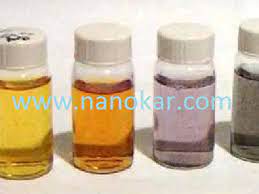
In the studies of soft Nanomaterial powder application in lubricant compositions, we have used electroexplosive nanomaterial powder of copper, zinc, and brass (alloy LS 59-1L, containing 57-60% of weight of Cu; 0.8-0.9% of weight of Pb, the rest is zinc).
The experiments show that friction component wear and friction coefficient depend both on the type of nanomaterial powder and on the hardness of the friction component surface (Table 1). The data presented below show that wear magnitude depends on which of the friction components was exposed to heat treatment (quenching up to 58 HRC in hardness) – moving shaft or fixed blocks.
Fig. 1. 2D-profiles of the friction component (block) after tribological tests:
1 – pure oil I-20, 4 – oil I-20 + 0.3% of weight of brass nanomaterial powder.
If the shaft is heat treated, block wear reduces with nanometaril powder of Zn, CuZn, and Cu. If the blocks are heat treated, a slight wear reduction was observed only with Zn and brass nanomaterial powder. Fig. 1 shows block profile after the tests where the shaft was heat treated.
It appears that the formation of cladding layers on the surface of the friction component is caused by mechanical processes of nanoparticle penetration into block surface layers, which are in their turn defined by surface layer hardness. The near-surface layers of friction components ended up containing elements of copper and zinc up to the depth of 0.2 μm, with uneven distribution on the surface.
Friction component wear also depends on the nature of base oil. Table 2 shows the results of antiwear tests in A-8 oil carried out in Omsk Tank Institute. The data presented in the table show that the lowest wear of friction components is observed when the oil is doped with a copper powder.
Fig.2 Relation of friction component wear in the medium of I-20 oil and I-20 oil doped with nanomaterial powder of copper (Cu), brass (Cu-Zn), zinc (Zn)
The lowest friction coefficient is observed when nanomaterial powder of copper and brass are used, with loads of about 800 N. There is no essential decrease of the friction coefficient when zinc nanomaterial powder are used. However, certain decrease of the friction component wear is observed when using nanomaterial powder of all of the mentioned metals.
Table 3 shows the results of antiscuffing tests carried out in Tomsk State University of Architecture and Building. Adding Nanomaterial powder to the oil increases setting load value for all tested compositions. Copper nanomaterial powder proved to be the most efficient, with setting load value increased 1.83 times.
Tests of the overall vibration level of bearings 180307 filled with lubricants of various types, including nanomaterial powder-doped ones, were carried out in the laboratory of Tomsk plant Roltom. The measured characteristic was the value of the relative vibration level of the bearing θ = θ2/ θ1, where θ1 is the vibration level of an “open” (not filled with any lubricant) bearing (dB), θ2 is the vibration level of a bearing filled with lubricant (dB).
Test results (Table 4) show that maximum decrease of the vibration level is observed for bearings filled with LZ-31 lubricant plus lead-tin alloy nanomaterial powder and Litol-24 lubricant plus copper nanomaterial powder.
Tests of Rovel Thread lubricant, Litol-24 lubricant doped with copper and zinc nanomtarial powders carried out at Perm Lubricants Plant showed the following. If normal weld load (Рw) for the base lubricant is 668 kilogram-forces, after adding copper powder Рw > 1,000 kilogram-forces, after adding zinc powder Рс = 800 kilogram-forces.
Engine oil additives based on electroexplosive nanomaterial powder of copper, brass, and zinc are commercially available and manufactured in small lots under the Garant-M trademark.
Conclusions:
1. Lubricating media consisting of oils with nanomaterial powder of copper, brass, and zinc provide better antiwear properties of the steel-steel friction pair under high loads than finished oils. Adding nanomaterial powder to finished oils allows certain enhancement of antifriction properties of the base oil. The reduction of wear magnitudes and friction coefficient depends on the type of base oil used, the type of nanomaterial powder, and friction component hardness.
2. The enhancement of antiwear and antifriction properties of the friction pair after adding nanomaterial powder to the base oil is presumably due to the formation of nanomaterial powder particles on the friction component surface and their penetration into the near-surface layers.
3. A promising area of enhancing the properties of finished lubricants is the use of nanomaterial powder for doping consistent greases.
